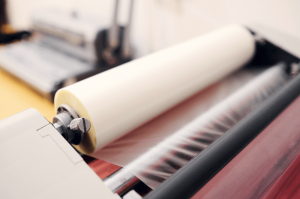Applying a clear plastic laminate is an optional finishing practice. It’s one that can benefit all kinds of print projects. The laminate provides a protective layer against moisture and dirt. What’s more, it is possible to use it to enhance the texture and sheen of pieces. Since they extend the lifespan of the printing, they are also a cost efficient option. So, laminating services are incredibly popular at the moment.
The laminates for print projects are generally thin plastic film sheets. However, there are multiple thicknesses to choose from. Since this is the case, you need to know what you are working with. That is what we are going to discuss here, covering three of the main options.
1.5 mil thickness
 A 1.5 mil laminate is among the thinnest options available. It tends to be used on projects using card stock. Examples would be book covers, postcards, presentation folders, and business cards. As card stock is already sturdy by itself, you don’t really need heavier laminate films. Using a 1.5 mil one will often meet your needs.
A 1.5 mil laminate is among the thinnest options available. It tends to be used on projects using card stock. Examples would be book covers, postcards, presentation folders, and business cards. As card stock is already sturdy by itself, you don’t really need heavier laminate films. Using a 1.5 mil one will often meet your needs.
What’s more, as 1.5 mil film is so flexible and thin, it’s a decent fit for projects that you will fold. Think pamphlets, brochures, visitor guides, and event programs. Also, because it is one of the most economical laminates, it works for projects that have short lifespans. These include flyers, instruction sheets, and sell sheets.
3 mil thickness
The 3 mil laminate is next. This one strikes a good balance between durability and flexibility. It comes with twice the resilience and thickness as the 1.5mil variant. Even so, this is still a lighter duty option. Since it showcases some flexibility, you can use it for many of the projects you use the thinner film in.
Despite 3 mil films having double the thickness, you can still fold print pieces easily. So, you can use them for tri-folded or bi-folded restaurant menus. Moreover, as it has decent resilience and is light in weight, you can use the film for charts, posters, and maps. You can use it for other printed sheets meant for display on vertical surfaces too. The flexibility also enables you to roll up the larger sheets and put them in shipping tubes for transport. Speak to us if you need first class laminating services.
5 mil thickness
The last film we will discuss is 5 mil. This is a popular option that adds a moderate amount of stiffness to print items. Thus, it works well on projects that don’t need folding. These include flat bar and restaurant menus or placemats.
The laminate’s durability makes it a wonderful choice for regularly-handled education materials. Additionally, it is a viable thickness to use on flashcards and other card sets handled often.
Thanks to the high structural integrity, a 5 mil laminate can work for sheets and cards bound together with a metal ring or ball chain inserted via a punched hole. If necessary, you can add metal grommets for more reinforcement to the holes.
Furthermore, the 5 mil thickness is useful for bookmarks. This includes ones printed for use with promotional giveaways. The film increases the bookmark’s durability considerably. This stops tears and creases.
We understand laminating services
At Foiling Services, we have become an authority on how to best laminate items. Our team understand the process and how delicate it is. As such, we can ensure we deliver the most consistent results every time.
So, if you’re interested in arranging laminating services with us, feel free to get in touch. We’re happy to provide advice too, including recommendations for laminate thickness if you are unsure.
